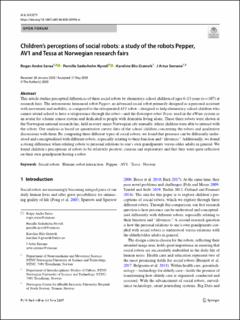| dc.contributor.author | Søraa, Roger Andre | |
| dc.contributor.author | Nyvoll, Pernille Søderholm | |
| dc.contributor.author | Grønvik, Karoline Blix | |
| dc.contributor.author | Serrano, Artur | |
| dc.date.accessioned | 2020-06-08T08:46:55Z | |
| dc.date.available | 2020-06-08T08:46:55Z | |
| dc.date.created | 2020-06-05T12:48:27Z | |
| dc.date.issued | 2020 | |
| dc.identifier.citation | AI & Society: The Journal of Human-Centred Systems and Machine Intelligence. 2020 | en_US |
| dc.identifier.issn | 0951-5666 | |
| dc.identifier.uri | https://hdl.handle.net/11250/2657133 | |
| dc.description.abstract | This article studies perceptual differences of three social robots by elementary school children of ages 6–13 years (n = 107) at research fairs. The autonomous humanoid robot Pepper, an advanced social robot primarily designed as a personal assistant with movement and mobility, is compared to the teleoperated AV1 robot—designed to help elementary school children who cannot attend school to have a telepresence through the robot—and the flowerpot robot Tessa, used in the eWare system as an avatar for a home sensor system and dedicated to people with dementia living alone. These three robots were shown at the Norwegian national research fair, held in every major Norwegian city annually, where children were able to interact with the robots. Our analysis is based on quantitative survey data of the school children concerning the robots and qualitative discussions with them. By comparing three different types of social robots, we found that presence can be differently understood and conceptualized with different robots, especially relating to their function and “aliveness.” Additionally, we found a strong difference when relating robots to personal relations to one’s own grandparents versus older adults in general. We found children’s perceptions of robots to be relatively positive, curious and exploratory and that they were quite reflective on their own grandparent having a robot. | en_US |
| dc.language.iso | eng | en_US |
| dc.publisher | Springer Verlag | en_US |
| dc.rights | Navngivelse 4.0 Internasjonal | * |
| dc.rights.uri | http://creativecommons.org/licenses/by/4.0/deed.no | * |
| dc.title | Children’s perceptions of social robots: a study of the robots Pepper, AV1 and Tessa at Norwegian research fairs | en_US |
| dc.type | Peer reviewed | en_US |
| dc.type | Journal article | en_US |
| dc.description.version | publishedVersion | en_US |
| dc.source.journal | AI & Society: The Journal of Human-Centred Systems and Machine Intelligence | en_US |
| dc.identifier.doi | https://doi.org/10.1007/s00146-020-00998-w | |
| dc.identifier.cristin | 1814024 | |
| dc.description.localcode | Open Access This article is licensed under a Creative Commons Attribution 4.0 International License, which permits use, sharing, adaptation, distribution and reproduction in any medium or format, as long as you give appropriate credit to the original author(s) and the source, provide a link to the Creative Commons licence, and indicate if changes were made. The images or other third party material in this article are included in the article's Creative Commons licence, unless indicated otherwise in a credit line to the material. If material is not included in the article's Creative Commons licence and your intended use is not permitted by statutory regulation or exceeds the permitted use, you will need to obtain permission directly from the copyright holder. To view a copy of this licence, visit http://creativecommons.org/licenses/by/4.0/. | en_US |
| cristin.ispublished | true | |
| cristin.fulltext | original | |
| cristin.qualitycode | 1 | |

